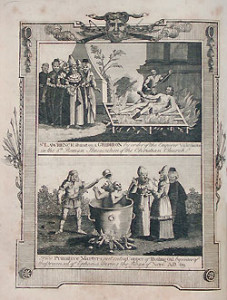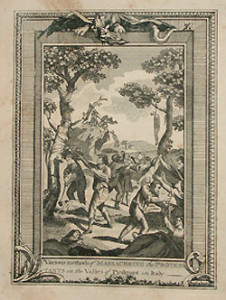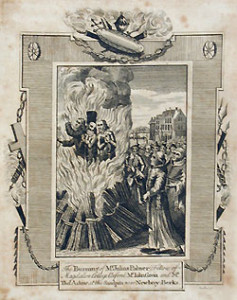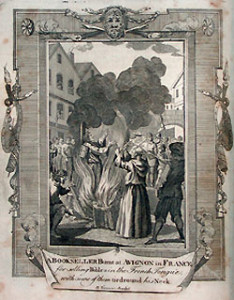Killing, and dying, in the name of God in the New World
One of the most chilling images in early American history is the deliberate firing of Fort Mystic during the Pequot War of 1637. Five hundred Indian men, women, and children died that day, burned alive along with their homes and possessions by a vengeful Puritan militia intent on doing God’s will. “We must burn them!” the militia captain famously insisted to his troops on the eve of the massacre, in words that echo the classic early modern response to heretics. Just five months before, the Puritan minister at Salem had exhorted his congregation in strikingly similar terms to destroy a more familiar enemy, Satan; “We must burne him,” John Wheelwright told his parishioners. Indians and devils may have been scarcely distinguishable to many a Puritan, but their rhetorical conflation in these two calls to arms raises a question: Was the burning of Fort Mystic a racial or a religious killing?
The simple, and no doubt right, answer is that it was both. In early modern Europe, people were defined as much by what they believed as by how they looked. The line between Christian and non-Christian was the one fundamental divide that separated people, communities, and kingdoms into hostile camps, and it certainly does not surprise us to see seventeenth-century Christians (not to mention latter-day ones) justifying bloodshed in the name of God. In the British North American colonies, where the “sacred” had a more tenuous material and institutional existence and where legitimacy of any kind was harder to come by, it is nearly impossible to disentangle religious violence from other forms of aggression. One could easily say that all actions undertaken by European settlers to defend themselves and their communities in the vast missionary field that was the New World bespoke religious anxieties and aspirations. But having said this, it is still possible to place some phenomenological and interpretive boundaries around the problem of “religious violence.” What forms of violence should we categorize as “sacred” violence, and how do we know when notions of the sacred are at stake in acts of violence, whatever form they might take? (I should note that, though I am using the terms sacred and religious interchangeably, there is a difference: as I’ve come to understand the terms, the sacred refers to all that which exists outside or transcends the human sphere, whereas religion refers to those practices and institutions that defend the sacred within the human sphere. Sacred is the more encompassing term and the less definable.)
A survey of the myriad ways Europe’s Christians found to kill and maim one another in the sixteenth and seventeenth centuries—the age of the wars of religion—would uncover formal and rhetorical similarities in narratives of martyrdom, massacre, iconoclasm, judicial torture, and orchestrated assaults (both popular and state-sponsored) on dissenting communities. The colonial Indian wars of the seventeenth century fit very comfortably in this historical landscape; in numerous ways, these wars may best be understood as continuations and extensions of Europe’s wars of religion. Nearly identical forms of violence marked all these events (burning of innocents, dismembering of combatants and posthumous violations, destruction of sacred objects such as Bibles, cannibalism and other ritualized acts of consumption of one’s enemies, and a central preoccupation with blood and its purgative and purifying properties). And, perhaps more tellingly, these atrocities were often described in identical language from one genre to the next; the tortures endured by martyrs at the stake in the Old World, so meticulously and lovingly described by Reformation and Counter-Reformation propagandists, are exactly replicated in narrative detail in the graphic accounts of the Indian wars published by sympathetic missionaries in the New World. (The parallels are even more pronounced in Spain’s conquest of its Indian population.)
This is grim reading. And I will spare you the gory details. My point is simply that there are striking similarities between New World violence against indigenous peoples, perhaps the exemplary form of colonial violence, and the European wars of religion, which many historians consider the apex of human savagery in the early modern era. The formal and rhetorical similarities only take us so far, however, in understanding the role of the sacred in colonial violence. Ultimately, what seems to distinguish sacred violence from other acts of aggression is not its form but its intensity. Certain thresholds (emotional, ideological, and perceptual) had to be crossed in order for violence to be interpreted and sanctioned as serving religious ends rather than secular ones. Religious wars, by definition, seem to be more brutal, more zealous, and less tempered by regret or remorse than other forms of warfare. This is not a new or very interesting insight; we’re reminded daily of the ferocity and single-mindedness by which people defend their faith in the face of perceived threats. But it may be useful to explore just how, and where, thresholds of legitimacy come to be established in different cultures and why and how the sacred is invoked.
Many gifted thinkers have devoted considerable energy and creativity to decoding the relationship of violence to the sacred. Some have suggested that all violence is in some sense sacred, that it is rooted in the deepest human desire to defend what is most precious and transcendent. Others have reminded us just how central acts of violence (the crucifixion, for example) are to the core principles and symbols of the world’s great religions. From René Girard’s classic anthropological theory of sacrificial rites to Elaine Scarry’s imaginative reading of the imagery of wounds and wounding in the Old and New Testaments to Ariel Glucklich’s much more recent theory of the psychological roots of “sacred pain,” scholars from across the disciplines have tackled the ubiquitous association of religion with violence.
For the historian of colonial America, the question is not the ubiquity of religious violence but the apparent scarcity of it. The starkest and most brutal forms of persecution—the burning of heretics, wholesale destruction of sacred places and objects, the forced expulsion and enslavement of outsiders such as Jews and Huguenots—were noticeably absent from the British colonies. But the European periphery produced new and sometimes bizarre forms of sacred violence: the ritualized assaults by Puritans on witches and Indians, which some scholars consider a peculiar form of iconoclasm; the proliferation of martyr tales within the context of slavery and Indian captivity; and the emergence of a hyperbolic rhetoric of suffering and redemption that traveled easily from religious to secular genres. Colonial Americans seemed (in good Protestant fashion) particularly adept at vicarious forms of violence. Words and objects, not people, were their main targets.

There is one obvious answer to this puzzling lack of traditional religious violence: the absence of the traditional targets of such violence—cathedrals, religious art, shrines, and, above all, significant urban concentrations of “outsiders” like Catholics and Jews. Furthermore, the structural weaknesses of the colonial governments meant that the religious disaffected had neither the resources nor the institutional backing to mount a serious assault on the objects of their rage. It is no coincidence that the only instance of official martyrdom (the execution of four Quaker missionaries in Massachusetts in the 1650s) occurred in a colony that boasted both a strong established church and a powerful magistracy. When we consider that the era of mass execution of heretics had largely ended by the time the British colonies were settled (the last Englishman burned at the stake for heresy was Edward Wightman in 1611), it is perhaps not surprising that so few colonists died for their beliefs. Moreover, the spectrum of popular sacred violence in Europe—which included such acts as cursing, blasphemous songs and jokes, and carnivalesque gestures aimed at reinforcing popular morality—also narrowed noticeably in the American colonies. The ecclesiastical landscape in North America simply didn’t offer the same opportunities for expressing sacred rage as the Old World, even if that rage continued to simmer in the hearts of European settlers who had so recently endured so much pain and suffering on account of their own religious beliefs.
A significant proportion if not an outright majority of immigrants throughout the seventeenth and eighteenth centuries were driven to the colonies by religious persecution at home—the Puritans, of course, but also the Quakers, Huguenots, Scots-Irish Presbyterians, German Pietists, Moravians, Shakers, and a smattering of minor sectaries such as the Dunkards and Muggletonians. For some of these migrants, the experience of persecution was a fresh wound, still bloody and raw, not a theological abstraction. (Some, most famously the Moravians, managed to ground both their collective historical memory and their theology in the image of blood and wounds.) And yet, the colonial settlements that mushroomed along the Atlantic coast in the late seventeenth and eighteenth centuries were, by and large, safe (or at least, non-lethal) environments for new generations of religious dissenters.
So much inflamed passion, so little actual persecution: such is the conventional story of colonial America’s religious history. Take martyrdom, for example. Martyrdom was the paradigmatic experience of sacred violence in the Reformation and Counter-Reformation eras—the ultimate expression of a community’s willingness to kill, and die, in the name of God. What immediately strikes the colonial historian is how few people were martyred for their faith in British North America. To provide some background: the most recent survey of early modern European martyrdom concludes that, as a conservative estimate, some 5000 people were judicially executed for religion in the sixteenth and seventeenth centuries, customarily by burning at the stake. If we expand this figure to include those whose deaths were the indirect result of legal prosecution or popular protest (those who died while imprisoned, for example, or who perished in religious riots), the number quickly climbs into the tens of thousands. Not every death produced a martyr, of course—martyrdom is an interpretive as well as a judicial category, the product of a particular believer’s conviction and a particular community’s need for heroes—and Europe’s Christians were assisted in the task of identifying and promoting martyrs by a well-oiled literary machine that poured thousands of martyr pamphlets from its presses. Post-reformation Europe was, in historian Brad Gregory’s words, “awash in martyrological literature.”
Protestants proved, somewhat surprisingly, to be as adept at promoting the cult of martyrdom as the late medieval church had been—this despite their opposition to cults of any kind. The Protestant martyr was, in many respects, the successor to the Catholic saint: an exemplary figure whose spiritual heroics helped close the immense gulf separating God from man. Unlike saints, martyrs had no supernatural or intercessory powers, but, at the moment of a martyr’s death, believing witnesses could see the face of God shining through the flames. Martyrs’ lives and, especially, their deaths were told and retold, compiled into massive compendiums that served as important textual supplements to the Bible for a new generation of reformers. The most influential of these martyrologies was John Foxe’s eight-volume Acts and Monuments (known colloquially as the Book of Martyrs), first published in English in 1563 and widely available throughout the Anglophone world, including the American colonies. Colonial children were introduced to Foxe’s martyrs from an early age in the pages of the New England Primer, and the town of Concord helpfully purchased its own copy to be made available to all residents.
From the very beginning, then, narratives of martyrdom were as important as the experience of the stake itself in shaping the devotional style and religious subjectivity of English Protestants. Those who did not have to face the prospect of actual death could read about the deaths of others just like them. Martyrologies like Foxe’s were thus instructional manuals as well as commemorative histories: they showed faith to be an act of constant sacrifice, and they told ordinary believers how to defend their faith in the face of terrible pressures. The Protestant martyr was, first and foremost, a humble lay man or woman, not a religious superhero. The Quakers, formally the Society of Friends, best exemplify this ethos of universal martyrdom: a self-designated “suffering people,” Quakers understood suffering to be a collective not an individual experience and so made no distinction in their official records between the heroics of a select few and the more mundane deprivations endured by the many. All Friends were, in some sense, martyrs. “Narratives of suffering” were collected and published by the Society in the thousands to celebrate the whippings, imprisonments, financial hardships, and innumerable indignities inflicted on Friends by a tyrannical and unmerciful government. One such pamphlet “promiscuously” recorded the sufferings “as they were promiscuously inflicted,” and proceeded in an incantatory tone to enumerate “all the sufferings therein: the blood of those whom you had put to death, and the Earsthat you had cut, and the Backs that youhad torn, and the Limbs that you had endeavoured to starve, and the Bellies that you had kept empty, and the Houses and Estates that you have laid waste and devoured, and the necessities and straitsyou had put and exposed the People of the Lord unto . . . for their Conscience to God.”
In the Quaker literature, martyrdom came perilously close to meaning persecution of anykind, no matter how mild or unspectacular. Other Protestants, especially their sectarian opponents, did not go this far, but all Reformers participated in this project to conflate suffering and death and to make narratives of suffering central to the community’s understanding of itself. There is a basic paradox here. Protestants came to experience martyrdom as both a normative category and an exemplary one: something that everyone might—even should—aspire to but that most would experience only vicariously as readers. As the historian of print David Hall points out, “to read about the martyrs was not the same thing as becoming one.” Protestants, it seems, wanted to have it both ways.
This was especially true in the colonies. If European settlers were relatively unfamiliar with the spectacle of executions for heresy, they proved avid consumers and producers of martyr tales—both imported and homegrown. Turning from legal records to pamphlet literature, we find martyrs everywhere in colonial America: Indian captives such as Mary Rowlandson who saw their ordeal as a testing of faith; Puritan and Anglican missionaries who loved to recount the hardships and deprivations they endured in their pursuit of souls in America’s wild backcountry; colonial soldiers in the many wars of empire fought on American soil in the late seventeenth and eighteenth centuries who believed they were redeeming the continent for God and King; long-suffering colonial magistrates and governors who felt persecuted by the ungrateful and importunate masses they were supposed to be governing.
Such martyr tales did not cease with the eighteenth-century dissemination of Enlightenment ideas about a rational and self-regulating universe that presumably demanded little heroic sacrifice and self-denial from its human subjects. As long as new sectarians continued to arrive from bloody Europe, as long as martyr tales continued to sell briskly, as long as the Protestant impulse to glorify suffering remained intact, the image of the martyr continued to exert a powerful pull on the colonial mind.
The British colonies were thus “awash” in martyr literature, a fact that returns us once again to the central paradox of colonial martyrdom: colonial martyrs were everywhere, religious violence (of the kind recognizable to early modern Christians or to historians of the Reformation era), in short supply. What, then, are we to make of this oversized colonial martyr complex? Was this just a rhetorical hangover from a European past, or was it a symptom of deep-seated anxieties about the precarious nature of the “sacred” in a dangerous and alien land? And does it matter, or rather, howdoes it matter that martyrdom was primarily a textual experience in colonial America?
This question, among others, has been at the heart of recent efforts to apply the insights of Michel Foucault and Norbert Elias to the historical experiences of Anglo-Americans in the seventeenth and eighteenth centuries, a period which saw enlightenment but also savagery: corporal punishment began to disappear from the judicial landscape, but the disciplining of slaves reached new heights of terror; blood feuds and shaming rituals were discredited by new generations of civil and political leaders, but successful new evangelical and pietistic movements restored the language of blood and sacrifice to religious practice; the sentimental novel captured the hearts of Anglo-America’s middle classes, but quasi-pornographic tales of sadistic cruelty and sexual violation moved the souls of abolitionists and other middle-class reformers. At the heart of this conundrum is the printed word’s capacity to (re)-create bodily experience—to capture for readers the physical sensations associated with a given activity (torture, enslavement, death, sex, birth).
The boldest interpretations of the early modern print revolution argue that texts and their readers became the predominant model for theories of human society: actors became spectators as the chaos of lived experience was sorted into clean and coherent linear narratives in which the particular was supplanted by the universal. In this interpretation, the stories people tell themselves about their lives in a modern world are truer, more consequential, than life itself. More cautious interpretations stress the circular, limiting quality of print, in which stories, however visceral and compelling, remain just that—stories. One conclusion is clear from all this: bodies and texts bear an imperfect and unstable semiotic relationship to one another. Neither can be a substitute for the other, yet, in a certain sense, neither exists without the other.
This is a pretty long-winded way of saying what David Hall said much more succinctly—reading about martyrs is not the same thing as becoming one. Still, I think we can make a case that something of the dread, terror, and ecstasy of martyrdom was available to readers. An interesting comparison is the literature of Indian-hating, which colonists produced in large quantities during the eighteenth century, especially during the French and Indian War. Though horrific in tone and graphic in content, much of this literature was written by men and women who had never encountered a real Indian or faced a real tomahawk. What the historian Peter Silver has called “the agreeable horror of Indian-hating,” nicely captures the potent mixture of pain and pleasure such narratives produced in their readers. Reading about horror, after all, is never an entirely passive experience. It can have real emotional and ideological consequences: in the case of Silver’s war stories, hardened racial animosities and ethnic paranoia. In similar fashion, reading martyr tales may have been such a pervasive practice in the colonies precisely because of the absence of Old World sectarian persecution. Colonists had to find other, less immediate ways to fuel their faith. When we consider how quickly and vehemently anti-Catholic prejudices surfaced in the wake of the French and Indian War—at a time when the number of Catholics in the colonies was vanishingly small, and their institutional presence, entirely benign—we can see the political utility of keeping the memory of religious persecution alive in the form of martyr tales.
Of course, the ultimate irony is that, while the colonists were busy envisioning their own sufferings as a form of martyrdom, safe from the flames of religious hatred that still engulfed much of Europe, people were dying for their faith (or the faith of others) in the Americas. These people were not Europeans; many were not Christians or members of any faith recognized by Europeans. But they were clearly the victims of violence perpetrated in the name of God.
Should we extend the concept of martyrdom to include those who did not use or recognize the term? Should the five hundred Pequots who perished in the Fort Mystic massacre be considered “martyrs”? What about the Praying Indians who were herded onto a pestilential island in Boston Harbor during King Philip’s War and left to die while the Puritan militias burned Indian villages from Maine to Massachusetts? Or the peaceful Indians of the Moravian mission town of Gnadenhutten who were slaughtered by vengeful Scots-Irish farmers a century later in the Pennsylvania backcountry? We know that the German Moravians considered their Indian brethren at Gnadenhutten to be martyrs to the cause, and I suspect that New England’s Christian Indians had their own martyr tales to tell of King Philip’s War, even if they left almost no written accounts of their ordeal. To move further into the dark borderlands of the colonial “violence frontier,” how about the thousands of Africans who suffered (in Jon Butler’s provocative phrase) a “spiritual holocaust” when they were torn from their native villages and cosmologies and forced into slavery in the American South? Should the violence of renaming, the loss of African genealogical and spiritual roots, be compared to the violence of burning at the stake? And what of those slaves who were burned at the stake—the unfortunate men and women who fell victim to the southern slaveholders’ paranoia about fire and poison throughout the eighteenth century or, on a larger scale, the “conspirators” in the 1741 New York arson scare who formed a human bonfire at the hands of the city’s terrified citizens? How much of the ideological complex of European heresy hunting was recreated in the spectacle of slave malefactors or Indian villages being put to the flames?
These are questions not easily answered. And the answers depend in part on which perspective we wish to adopt—that of the victims or that of the aggressors. As Europe’s Protestants knew all too well, one person’s martyr was another’s heretic. From the perspective of the historian of the European colonial experience, it seems reasonable to suggest that the act of burning alive was an expression of religious anathema, whether reserved for heretics or racial others, and that those who suffered (and perpetrated) this horror were understood to be fulfilling religious roles. Whether construed as heathens, infidels, apostates, or devil worshippers, Indians and Africans occupied a position of spiritual significance for their European neighbors, and acts of violence directed against these religious and racial outsiders were, I would argue, always acts of sacred violence. In this sense, the terrible wars of religion that destroyed so much of Europe did not end in 1648 with the Treaty of Westphalia, or in 1689 with the Act of Toleration in Great Britain, or in 1710 with the final defeat of the Camisard Revolt in France but continued to gather victims well into the Age of Reason.
This article originally appeared in issue 6.1 (October, 2005).
Susan Juster is professor of history at the University of Michigan. Her recent publications include Disorderly Women: Sexual Politics and Evangelicalism in Revolutionary New England (1994) and Doomsayers: Anglo-American Prophecy in the Age of Revolution (2003). She is currently working on a cultural history of religious violence in the American colonies.























